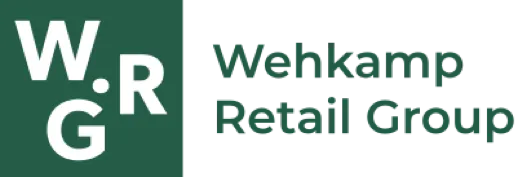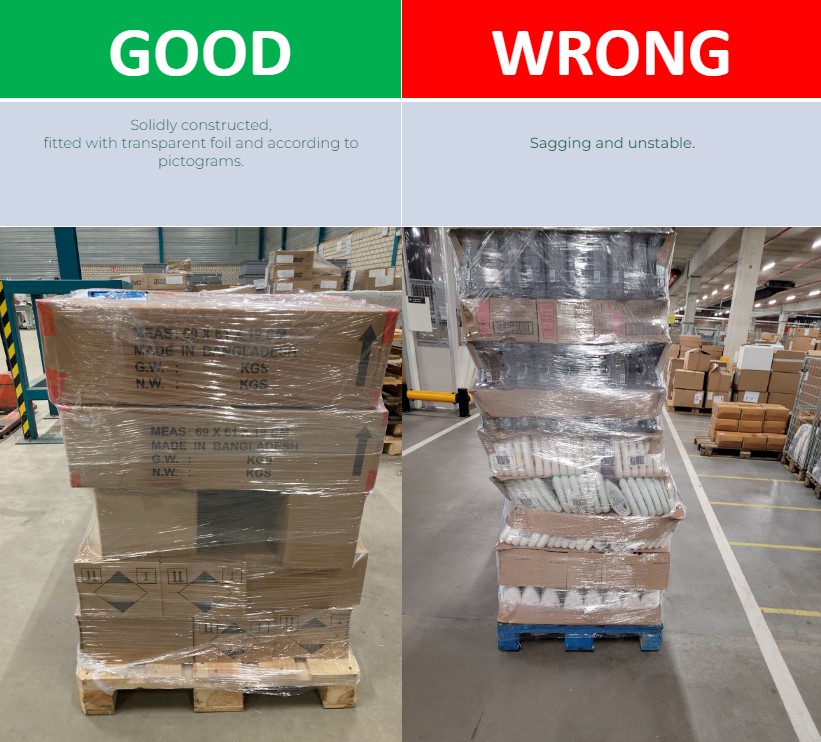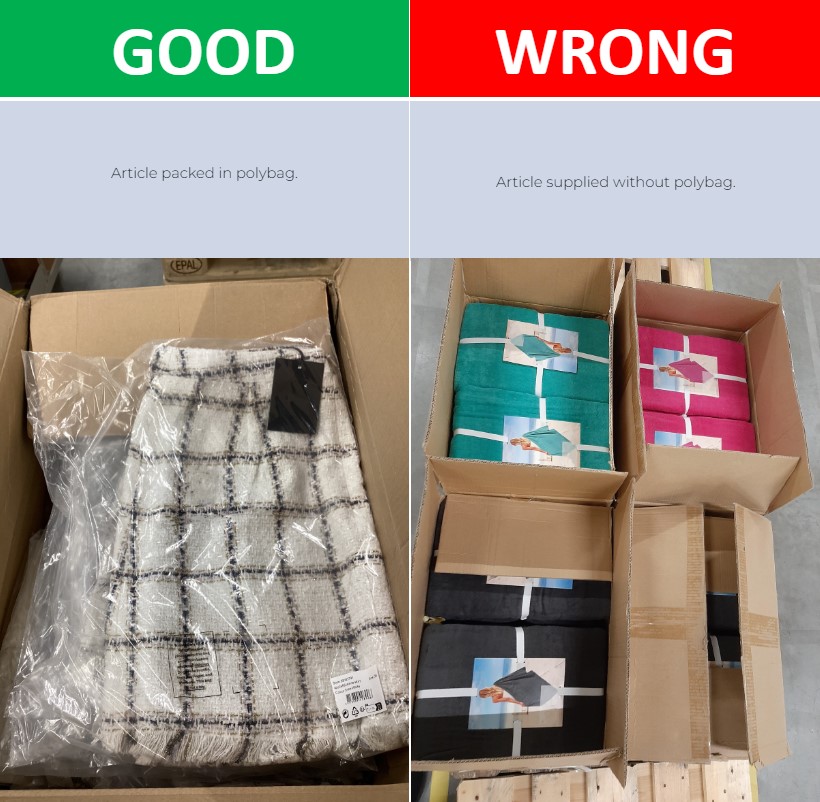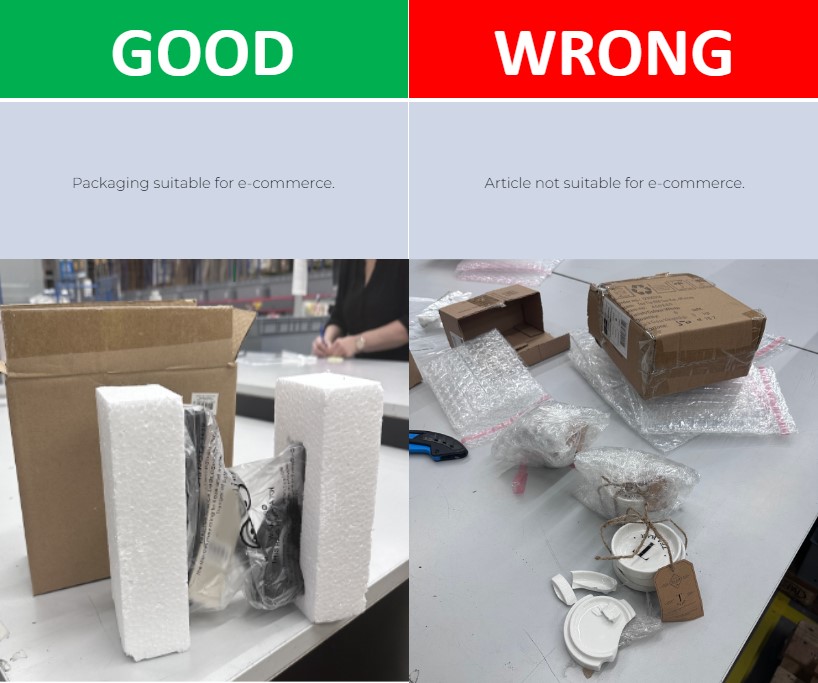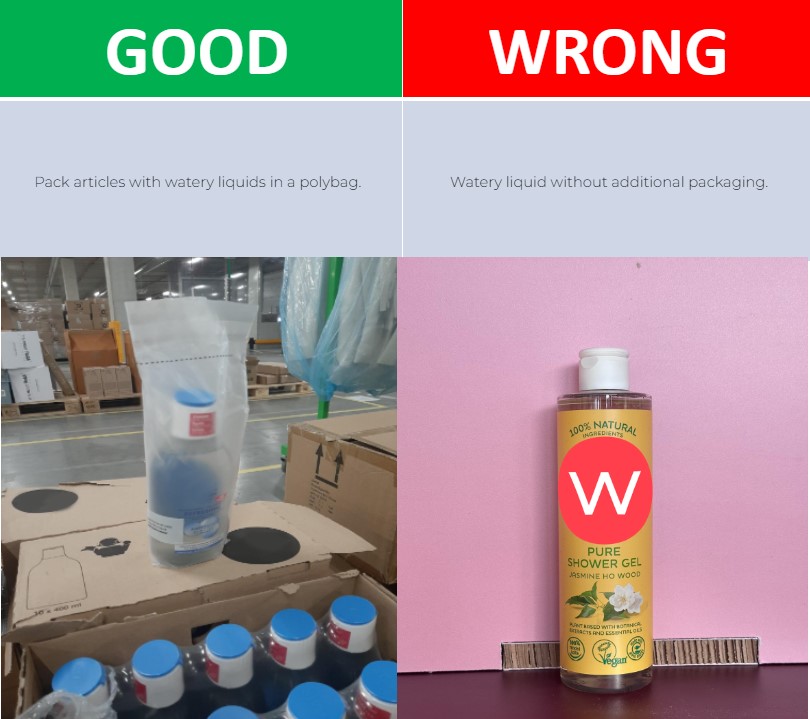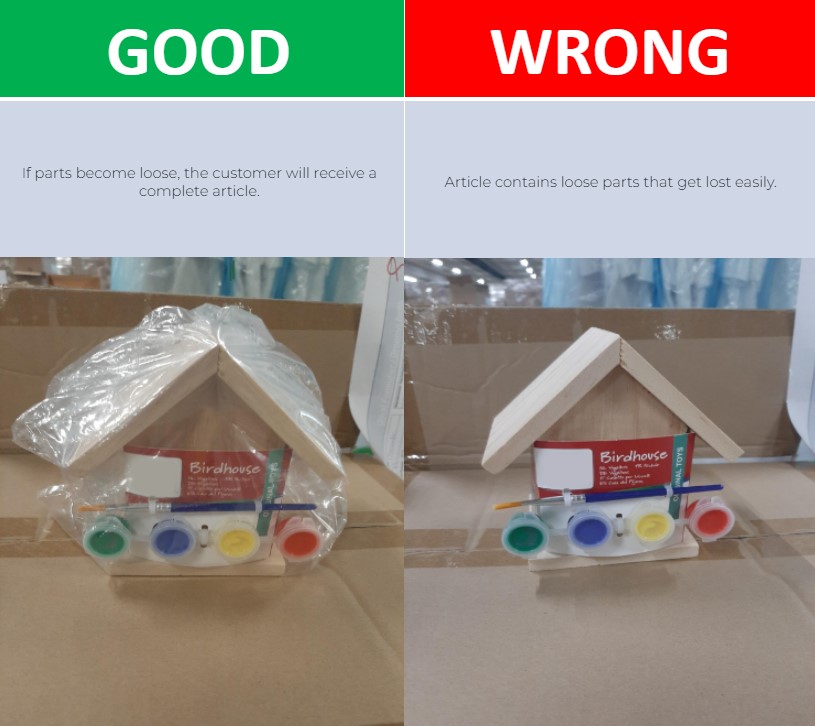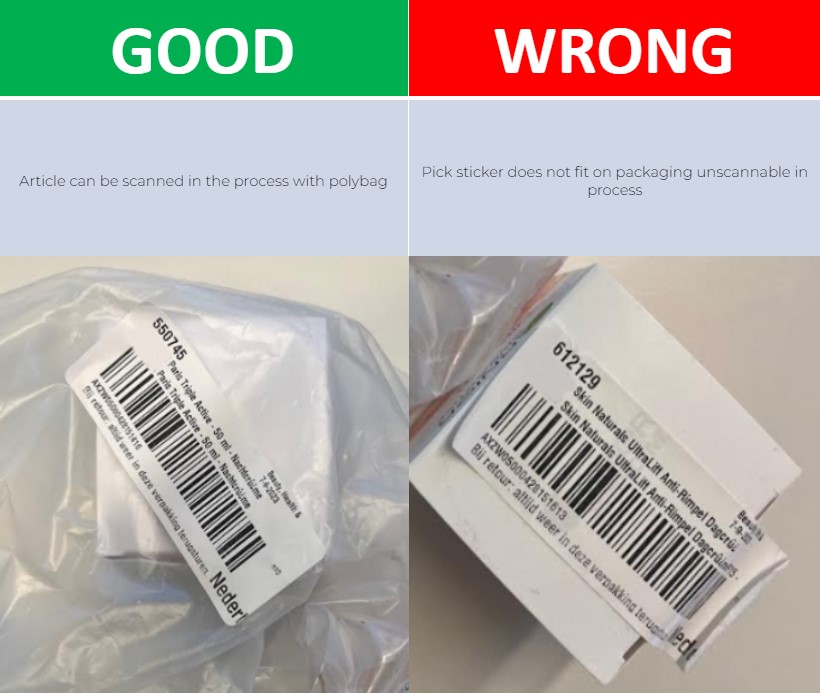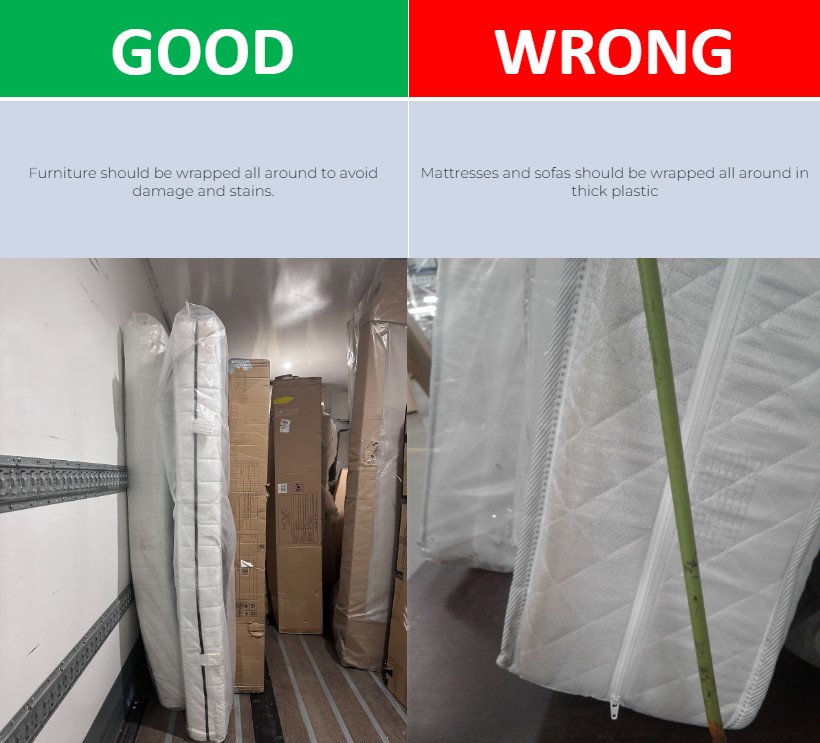1. Introduction
Wehkamp Retail Group B.V. (WRG) attaches great importance to a sustainable and transparent partnership in which efficiency, quality and innovation are central. This operational annex describes the logistics conditions and is designed to create clear frameworks for efficient cooperation. Good cooperation ensures lower integral costs and enables us to better respond to opportunities and changes from the market.
Thank you for complying with these terms and conditions. If there are any questions, please contact: Marc Muijtstege
2. Definitions and abbreviations
Article: Designation of the product that the supplier supplies.
ASN: ‘Advanced Shipping Notice’; a pre-announcement of a shipment.
Big goods: Items that are too large to be stored as ‘Small goods’ but are still suitable for DHL shipping. Maximum dimensions: 68 cm (length), 68 cm (width), 170 cm (height); maximum weight 25 kg and maximum volume 200 liters.
CMR: Waybill complying with the guidelines of the international CMR Convention and also a receipt for the goods.
Deviations: A defect, error and/or difference in quantity (shortage or excess) of an ordered item.
EAN/GTIN/UPC-A: Globally unique barcodes to identify articles.
EPAL or (CHEP): Accepted pallets that we can exchange from the common pool.
GS1: Global Standards One; the organisation that issues barcodes for article and carrier identification.
Hanging goods: Storage zone where goods are stored hanging.
LPN: Licence plate number; barcodes to identify a load carrier.
LSC(Z): Logistiek Service Center (Zwolle), this denotes our warehouse
Load carrier: A box, roll container, hanging rack or pallet.
SKU: ‘Stock keeping unit’, a numeric code used to identify a unique item in the range at the lowest information level. For example: a blue T-shirt in size L is a SKU. The same T-shirt in size M becomes another SKU
SKU mix: The carrier (often a carton box) consists of several items/SKUs. For example: T-shirts, toothbrushes and nail polish. Or 2 same T-shirts in the same colour but different sizes.
SKU pure: The carrier contains one type of article, all in the same size and colour.
Small goods: Items with maximum dimensions of 55 cm (length), 34.5 cm (width), and 25 cm (height).
Snakewise: Refers to the process by which cargo is stacked in a zigzag pattern so that SKUs are together as much as possible in boxes, on roll cages, pallets and in containers.
SSCC: SSCC is an abbreviation for Serial Shipping Container Code. An SSCC label is internationally recognised as a shipping code for load carriers.
VAS: Value Adding Services; the inbound department for articles that do not meet our e-commerce-ready requirements.
XXL goods: Weighing more than 25 kg, with a volume greater than 200 liters, or dimensions larger than 68 cm (length), 68 cm (width), and 170 cm (height).
3. General provisions
This document describes the logistics conditions for the delivery of items to WRG’s LSCZ. The purpose of these conditions is to process items efficiently and make them available quickly for sale to our customers. It also describes some important requirements, such as with regard to safety and permitted load carriers, as well as the consequences of not being able to comply with these conditions.
3.1. Safety
To prevent damage and injury, all safety measures applicable at WRG must be observed. The supplier is liable for (injuries resulting from) failure to comply with the applicable safety conditions. In this context, the following applies:
- The wearing of and fluorescent vest and safety shoes is compulsory at all times on the entire LSCZ site;
- The driver (and co-driver) must comply with the instructions of WRG staff and follow the (traffic) signs present;
- Gas-free declaration for a shipping container is mandatory
3.1.1. Terrain
To reduce risks on WRG’s premises, we request suppliers to observe the following:
- It is not permitted to park and exit in front of the barrier;
- A maximum speed of 15 km/h applies on the WRG site;
- Please prevent the trailer from rolling off the dockdock (place a chock under the wheels).
3.2. Contact details & opening hours
Adress LSCZ Hal 1&2
(Creative Hub, Small goods en Big goods)
Pommerenstraat 4, 8028 NA, Zwolle
Adres LSCZ Hal 3 (XXL)
Pommerenstraat 2, 8028 NA, Zwolle
Arrival office
[email protected]
EDI team
[email protected]
Value Adding Services
[email protected]
Invoices
[email protected]
Unloading times
8:00 until 16:00 (monday until friday)
3.3. Defects, faults and deviations in quantity
From the time of delivery of the articles by the supplier, WRG aims to inspect the supplied articles for discrepancies within four working days. WRG will report discrepancies to the supplier and will charge the value of a discrepancy to the supplier, or offset it against an invoice still to be paid.
WRG reserves the right to (partially) cancel a Purchase Order and reject a deviation and return it (at the supplier’s expense) to the supplier. In the case of the return of a deviation, ownership and risk of shipment/receipt shall pass to the supplier as soon as WRG has dispatched these items.
Consequences
Failure to comply with WRG’s logistics conditions may result in:
- Refusal of a delivery;
- Return of a delivery to the supplier; and/or en/of
- Charging the supplier for repairs carried out (VAS) and/or shipping costs.
- Stopping accepting new deliveries until all previous shipments have been processed or collected.
4. Logistical onboarding
The onboarding lays the foundation for transparent and effective communication between the supplier’s logistics operation and WRG. During onboarding, we ensure that our processes are aligned both physically and digitally. In addition, the onboarding ensures that during the cooperation, unnecessary costs and delays are avoided and customers are provided with the best possible service.
Onboarding process
The following steps take place (in sequence) for the onboarding process:
- Following contract negotiations, there is contact with the vendor performance coordinator (‘VPC’) of WRG’s Supply Chain team to go through (in about 30 minutes) the operational attachment with the vendor and answer any questions.
- If required, the Electronic Data Interchange (‘EDI’) team hooks up to test whether the supplier’s digital link to WRG is functioning properly.
- The VPC links back to the buyer so that the first purchase order can be sent.
- The first two shipments should be notified via the booking portal as VAS shipments. The merchandise planner or inventory controller requests a test for this shipment so that detailed feedback on the shipment is given to the supplier after the shipment.
- If WRG can process the shipments successfully, WRG’s arrivals office will send an email to the supplier that shipments can be pre-notified as regular shipments. If not, the supplier will receive a periodic statement of VAS costs from the third delivery onwards. This statement will specify which items have been processed via VAS. These articles should be notified as a VAS shipment in the booking portal.
For the first XXL shipment, the bookingportal can be used. WRG’s merchandise planner or inventory controller will request a checklist from the supplier so that the pre-notification and physical shipment are provided with feedback.
5. E-commerce ready labelling and packaging
WRG wants to avoid items being damaged or broken by incorrect packaging at all times. For choosing the right packaging, WRG recommends the following:
- Make a trade-off between the strength and durability of the packaging;
- In general, the higher the value of the article, the more protection is needed;
- Suitable packaging should be able to safely support the weight of the contents;
- Fragile articles should not touch the outer wall of the box;
- Awkwardly shaped articles require extra attention.
5.1. Labelling articles
A properly scannable barcode should be attached to articles.
When articles contain variables such as size, colour, flavour or functionality, a unique barcode should be used.
When in doubt, the decision-support tool from GS1.org can be used.
We accept the following standard barcodes:
- EAN;
- GTIN;
- UPC-A.
For additional packaging material, always take into account the scannability of the article barcode:
- Barcode should be at least 25 mm high and 50 mm wide;
- Human-readable interpretation under barcodes is mandatory.
Articles without barcodes will be irrevocably returned to the sender.
5.2. Built-up of load carriers
Built-up load carriers should comply with the following conditions:
- Maximum weight of pallet is 500 kg;
- Logistical units lighter than 4 kg may be stacked up to 220cm high;
- Logistical units from 4 to 20 kg may be stacked up to 180cm;
- Logistical units from 20 to 46 kg may be stacked up to 120 cm;
- Do not stack items heavier than 46 kg and always deliver on a pallet.
We accept the following load carriers:
- Roll containers (only if coordinated in advance);
- Transport containers (only if agreed in advance);
- EPAL or CHEP pallets (80*120 cm) mandatory for Big goods and XXL;
- Hanging racks (subject to hanging goods);
- Disposable pallets (80*120 cm), but only for Small goods deliveries;
- Solid size pallets for items exceeding the footprint of standard pallets;
- Block pallets (100 x 120 cm or 120 x 120 cm ) for XXL items.
We are forced to refuse load carriers for the following reasons, among others:
- Opaque stretch film for non-theft sensitive goods;
- Sagged or unstable pallets;
- Visible moisture, mould or other damage to items;
- Load carrier identification missing or illegible;
- Overall condition of load carrier is too poor to ensure safety.
Load carrier/box identification
Identification on load carriers should comply with the following conditions:
- Label format should be A5 or A6 size only;
- Use SSCC barcode labels;
- Other LPNs are permitted provided that:
- Unique (not more frequent across all shipments to WRG);
- In code 128 format;
- After approval during onboarding;
- Barcode should be minimum 32 mm high and maximum 165 mm wide;
- Human-readable interpretation under barcodes is mandatory.
- Delivery is made with LPNs at box level, pallet level, or both.
5.3. Set packaging & colli articles
If the article is a set of packages, this should be indicated on the packaging. It is sufficient if only the barcode of the set is scannable, without the barcode of the individual articles of which the set is composed being readable. If an article is made up of packages, it must always be stated on the packaging which packages it concerns and how many packages are needed for a complete article. Each package has a unique barcode applied to the narrowest side of the package.
5.4. Packing articles
The annexes to this Operational Annex contain a number of examples of correctly and incorrectly packed articles. If this section does not provide guidance for a particular article group, the VPC will tailor the packaging instructions.
Fragile articles
Fragile articles (such as crockery, glassware, lighting etc.) and fragile articles (such as liquids) should be packed in a way that prevents the risk of damage.
The article can be subjected to a drop test from a height of one metre; the article must be able to withstand a fall on all sides and corners without breaking.
Furniture, duvets and pillows:
Furniture (sofas, chairs, tables, cupboards, mattresses, rugs, pillows, etc.) should be packed individually for storage and delivery to customers. The packaging should be closed with strong glue or sturdy tape. The use of staples to close boxes is not allowed.
Additional packaging guidelines for this range can be found on wehkamplogistiek.nl.
Fashion, shoes and other textiles:
Fabric and textile articles are vulnerable to dirt and moisture and should be delivered sealed in a box or transparent polybag with material and dispose symbol. In addition, the following requirements apply:
- Fashion articles always tagged with the article-barcode;
- Clothing hangers are only allowed if the articles are intended for hanging storage.
- Articles may not contain any parts protruding from box or polybag (this also applies to tags);
- Price information on articles only allowed if the price matches the original retail price on the consumer website (repricing possible at VAS rates);
- Always deliver shoes in original packaging;
- Fabric articles such as soft toys should be packed in a sealed polybag or box;
- Packaging as thin as possible and as much as possible from recycled material.
- Provide articles in boxes with lids with strong elastic so that the lid cannot fall off the box during transport.
Sharp articles:
Sharp articles pose a safety risk to employees, transporters and customers. These articles should therefore be packed in such a way that sharp edges or points are protected during the logistics process.
Hygiene articles:
Hygiene articles cannot be resold after opening the packaging. The packaging should therefore always be delivered sealed. Consider the following article groups:
- Toothpaste;
- Care products;
- Erotics;
- Cosmetics.
Articles with limited shelf life:
We only accept articles with a best-before date (BBD) if the minimum best-before date is 6 months from the delivery date.
Articles containing hazardous substances:
Articles containing hazardous substances may be stored in the LSCZ only if the conditions below are met:
- Articles may be transported by DHL (Hazardous substances);
- Highly flammable liquids are supplied with outer packaging.
Articles containing hazardous substances should be collected within 24 hours in case of refusal.
6. Categories of articles
Below are the conditions for each item category, items must meet the conditions of a category.
6.1. Small goods
‘Small Goods’ are Items with maximum dimensions of 55 cm (length), 34.5 cm (width), and 25 cm (height).
The delivery of small goods must comply with the following conditions:
- Delivery must be in boxes, on a pallet or in a roll cage (roll cages and transport containers only by agreement);
- Small goods should be visibly separated from other categories of items, even if the shipment consists of individual boxes;
- SKU mix boxes are allowed, provided snakewise filled and bundled or separated by SKU. Use larger polybags, rubber bands or separation sheets for this purpose;
- Pallets or roll cages should be constructed snakewise;
- Items smaller than 3.5 x 9 centimetres must be packed in a polybag so that the pick sticker fits on the item;
- Items should be delivered without a clothes hanger in the packaging (excluding items destined for hanging storage).
6.2. Big goods
‘Big Goods’ are items that are too large to be stored as ‘Small goods’ but are still suitable for DHL shipping. Maximum dimensions: 68 cm (length), 68 cm (width), 170 cm (height); maximum weight 25 kg and maximum volume 200 liters.
The delivery of Big goods must comply with the following conditions:
- All goods shall be delivered on EPAL- or CHEP-pallets.
- Delivery on pallet boxes is permitted only after approval by WRG;
- The construction of a load carrier is preferably SKU clean. If this is not possible, the SKU mix is constructed snake wise;
- Each item is packed in a closed box suitable both for shipment to the customer and return by the customer;
- Big goods are separated from Small goods on delivery as much as possible.
6.3. XXL articles
‘XXL Goods’ are items that weigh more than 25 kg, with a volume greater than 200 liters, or dimensions larger than 68 cm (length), 68 cm (width), and 170 cm (height). These articles are not suitable for delivery via the DHL-network.
The delivery of XXL goods must comply with the following conditions:
- All goods shall be delivered on EPAL, CHEP, block or size pallet;
- Delivery without pallet is permitted only after approval by WRG;
- Truck loading and stacking on load carriers should be done in compliance with the pictograms present;
- Items should not exceed the footprint of the pallet;
- Maximum 1 SKU per pallet;
- XXL goods on a load carrier will not be combined with other categories of articles.
6.4. Hanging
Delivery takes place bundled by size in foil packaging on a clothes rack
- By agreement, it is permitted to deliver hangers in boxes;
- Permitted hangers F44, NF44 or NA43 of new quality with a fixed hook.
The delivery of hanging garments should meet all the criteria below:
- The hanging article falls into one of the following categories:
a. Jacket
b. Ski suit, ski jacket or ski trousers
c. Dress
d. Suit or costume (jacket + trousers)
e. Jacket, blazer, biker jacket or jacket
f. Trousers or skirts - The hanging article should have a selling price higher than €165.00;
- The hanging article is made of one of the following fabrics:
a. More than 30% wool (excluding dresses → wrap in polybag)
b. Linen
c. Silk
d. Leather
e. Suede
7. Arrival process
Below are the conditions for the arrival process, items should be notified according to the following conditions
7.1. General
WRG aims for the most sustainable logistics process possible, to avoid unnecessary transports we ask you to:
- Merge shipments from multiple purchase orders into one delivery;
- If volumes allow, send one delivery per week.
7.2. Schedule a delivery appointment
On wehkamplogistiek.nl, you will find the booking form. The form distinguishes between three types of bookings and four types of registrations:
- Book a time slot: Reserve a new time slot for your delivery.
- I have a scheduled delivery: Confirm the details of an already scheduled delivery.
- Manage my delivery: Reserve another time slot or cancel an already scheduled delivery.
- CSV: Choose this option when the packing slip is provided as a CSV file. Please refer to our CSV packing list template for more information.
- (i)EDI: Use this option if a connection via (i)EDI with WRG has been established. We will ask for a DESADV number.
- WDP: Choose this option for registration as an alliance via the WDP portal.
- Pre-registration: If you do not yet have a CSV packing list, DESADV reference, or WDP reference, you can reserve a time slot without the packing slip. Please note: once the packing slip or shipment reference is available, an additional registration is required.
7.3. GLN numbers
There are several delivery locations within WRG, each with its own GLN number. See below the different GLN numbers for the different delivery locations.
Usage: DP (Delivery Party) – GLN: 8714252002362 – Warehouse: Logistic Service Centre Zwolle – Address: Pommerenstraat 4 8028 NA Zwolle – Known as: Site ZWO
Usage: DP (Delivery Party) – GLN: 8719542002312 – Warehouse: Logistic Service Centre Zwolle – Address: Pommerenstraat 4 8028 NA Zwolle – Known as: Site ZW2
Usage: DP (Delivery Party) – GLN: 8719542100070 – Warehouse: Logistic Service Centre Zwolle – Address: Pommerenstraat 2 8028 NA Zwolle – Known as: Site LSCZ3
Usage: DP (Delivery Party) – GLN: 8719542100018 – Warehouse: Timing – Address: Pommerenstraat 4 8028 NA Zwolle – Known as: Site ZWO/VAS
7.4. Deviating from delivery agreement
If it is not possible to deliver at the agreed time, WRG should be contacted first. Availability of dock and unloading equipment is only guaranteed during the delivery block.
WRG is not liable for any waiting costs incurred.
Contact your merchandise planner in the following cases:
- The physical shipment contains more boxes or pallets than have been notified.
Contact Arrivals office in the following cases:
- The shipment does not appear on the scheduled date;
- The shipment arrives an hour before or after the scheduled delivery block.
7.5. Pre-register
A shipment should always be pre-notified via the portal on wehkamplogistiek.nl.
Each shipment must have a valid ASN. The following three methods to pre-notify a shipment are correct:
- DESADV via an Electronic Data Interchange connection between WRG and the Supplier;
- A DESADV created via the IEDI portal (after digital onboarding); or
- Upload one CSV file in WRG format via the portal on the wehkamplogististiek.nl (see appendix 1 for explanation)
Without a correct ASN, the supplier’s shipment will be refused.
Preferably, an ASN is provided with LPNs in the digital packing note. As far as possible, the supplier should ensure that LPN stickers are scannable from the outside of the pallet. The following information is mandatory here:
- Quantities;
- Article barcodes;
- Load carrier labels (LPN); and
- Purchase order.
The alternative is an ASN at article level. The following information is mandatory here:
- Quantity;
- Article barcodes;
- Purchase order.
7.6. Arrival
- Drive through to the barrier on the LSCZ premises;
- Driver reports with ASN at the counter of the arrivals office;
- Driver hands over ASN and CMR at the counter;
- Driver is assigned a dock number and assists in unloading operations;
- Damaged cargo is rejected and signed off on the CMR;
- EPAL pallets are only exchanged at the door, this is reported on the CMR;
- The consignment note is signed for receipt of the smallest unit indicated on the consignment note (pieces/collo/pallet);
- After signing off, we keep our part of the CMR for a period of 7 years;
- Digital CMR should be sent to [email protected].
7.7. Manco reporting
The LSCZ always carries out a 100% check of the goods delivered.
WRG aims to communicate defects and deficiencies to the supplier within five working days of inbound.
7.8. Sample shipment
Upon receipt of goods, WRG is entitled to carry out a random check. The driver is expected to wait for the sample to be completed.
A sample applies to the entire shipment. During the random check, it is checked whether the shipment matches the pre-notification. During sampling, boxes are opened to check numbers.
8. Value Adding Services
During onboarding, it is determined whether your articles meet the delivery conditions. If after the two test shipments your articles do not meet the delivery conditions, a surcharge per processed article will be charged. You can find the latest version of the rate card at wehkamplogistiek.nl.
Rates are based on three categories:
- Small goods – fashion & shoes
- Small goods – beauty en hardware
- Big goods
8.1. VAS operations
We perform the following operations at standard rates:
- Sorting: If snakewise delivery is not possible;
- Sorting: If quality control issues are identified;
- Folding and packaging: If packaging is not commerce ready;
- Masking or removal prices: If incorrect price is stated on article;
- Removing clothes hangers: If small goods articles contain hangers;
- Removing alarmtags: Removal of hard tags from clothing;
- Multipacks to singles: Break-up of articles delivered as a set;
- Singles to Multipacks: When an article is sold as a set or promo pack;
- Fragile articles: When the original packaging is not sufficiently protected; and
- Counting: If the shipment does not meet administrative requirements.
9. Annex 1: Pre-notification
Below are two options written out for pre-announcing using CSV files.
This template can be downloaded from the website Wehkamplogistiek.nl
After completing the template, it should be saved as a .CSV file and uploaded via the booking portal on Wehkamplogistiek.nl
